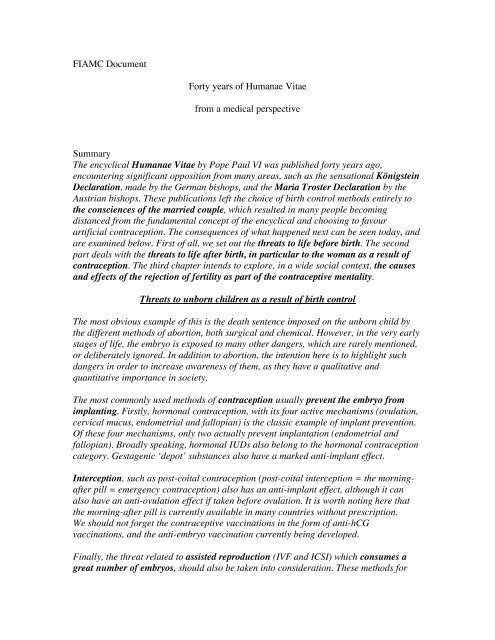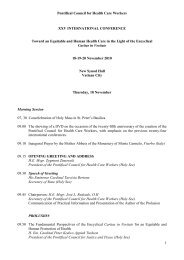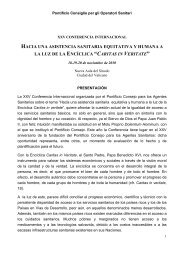FIAMC Document Forty years of Humanae Vitae from a medical ...
FIAMC Document Forty years of Humanae Vitae from a medical ...
FIAMC Document Forty years of Humanae Vitae from a medical ...
Create successful ePaper yourself
Turn your PDF publications into a flip-book with our unique Google optimized e-Paper software.
<strong>FIAMC</strong> <strong>Document</strong><br />
<strong>Forty</strong> <strong>years</strong> <strong>of</strong> <strong>Humanae</strong> <strong>Vitae</strong><br />
<strong>from</strong> a <strong>medical</strong> perspective<br />
Summary<br />
The encyclical <strong>Humanae</strong> <strong>Vitae</strong> by Pope Paul VI was published forty <strong>years</strong> ago,<br />
encountering significant opposition <strong>from</strong> many areas, such as the sensational Königstein<br />
Declaration, made by the German bishops, and the Maria Troster Declaration by the<br />
Austrian bishops. These publications left the choice <strong>of</strong> birth control methods entirely to<br />
the consciences <strong>of</strong> the married couple, which resulted in many people becoming<br />
distanced <strong>from</strong> the fundamental concept <strong>of</strong> the encyclical and choosing to favour<br />
artificial contraception. The consequences <strong>of</strong> what happened next can be seen today, and<br />
are examined below. First <strong>of</strong> all, we set out the threats to life before birth. The second<br />
part deals with the threats to life after birth, in particular to the woman as a result <strong>of</strong><br />
contraception. The third chapter intends to explore, in a wide social context, the causes<br />
and effects <strong>of</strong> the rejection <strong>of</strong> fertility as part <strong>of</strong> the contraceptive mentality.<br />
Threats to unborn children as a result <strong>of</strong> birth control<br />
The most obvious example <strong>of</strong> this is the death sentence imposed on the unborn child by<br />
the different methods <strong>of</strong> abortion, both surgical and chemical. However, in the very early<br />
stages <strong>of</strong> life, the embryo is exposed to many other dangers, which are rarely mentioned,<br />
or deliberately ignored. In addition to abortion, the intention here is to highlight such<br />
dangers in order to increase awareness <strong>of</strong> them, as they have a qualitative and<br />
quantitative importance in society.<br />
The most commonly used methods <strong>of</strong> contraception usually prevent the embryo <strong>from</strong><br />
implanting. Firstly, hormonal contraception, with its four active mechanisms (ovulation,<br />
cervical mucus, endometrial and fallopian) is the classic example <strong>of</strong> implant prevention.<br />
Of these four mechanisms, only two actually prevent implantation (endometrial and<br />
fallopian). Broadly speaking, hormonal IUDs also belong to the hormonal contraception<br />
category. Gestagenic ‘depot’ substances also have a marked anti-implant effect.<br />
Interception, such as post-coital contraception (post-coital interception = the morningafter<br />
pill = emergency contraception) also has an anti-implant effect, although it can<br />
also have an anti-ovulation effect if taken before ovulation. It is worth noting here that<br />
the morning-after pill is currently available in many countries without prescription.<br />
We should not forget the contraceptive vaccinations in the form <strong>of</strong> anti-hCG<br />
vaccinations, and the anti-embryo vaccination currently being developed.<br />
Finally, the threat related to assisted reproduction (IVF and ICSI) which consumes a<br />
great number <strong>of</strong> embryos, should also be taken into consideration. These methods for
curing sterility do ‘produce’ new life, but at a cost <strong>of</strong> innumerable embryos that have to<br />
be sacrificed as a result, without counting the losses attributable to selective pre-implant<br />
diagnosis. There are further dangers inherent in this case, among others for the children<br />
born following multiple pregnancies, which are much more frequent and result on one<br />
hand in selective foeticide and on the other in premature births with the related potential<br />
harm to the newborn. Excess embryos are given over to research on and with embryos,<br />
primarily research into embryonic stem cells, and even cloning.<br />
Even certain <strong>medical</strong> treatments not intended as contraception, such as endometrial<br />
ablation (laser and thermo) represent a threat to small embryos.<br />
The much vaunted modern lifestyle also has its own victims, although they are <strong>of</strong>ten<br />
hidden.<br />
Promiscuity promotes the transmission <strong>of</strong> sexually transmitted diseases (STD) that cause<br />
endometritis, such as Chlamydia, which may in turn have anti-implant effects.<br />
Little is known about the anti-oestrogen effects <strong>of</strong> nicotine, which also has an antiimplant<br />
effect on the embryo. Drugs such as LSD and cocaine also have an anti-implant<br />
effect.<br />
The extent <strong>of</strong> the anti-implantation effect <strong>of</strong> oral contraception is shown by the embryo<br />
destruction index (EDI) developed by Bayle. This calculation provides some chilling<br />
figures on the destruction <strong>of</strong> embryos, with at least 10 million such early abortions<br />
carried out every year around the world. If we compare the global figure <strong>of</strong> some 54<br />
million deaths registered (illness, accident, etc.) with the 42 million abortions plus these<br />
early abortions, overall the second figure exceeds the figure for ‘natural’ deaths <strong>of</strong><br />
people already born.<br />
Now if we consider that abortions and early abortions are done by doctors, surely we<br />
have to ask the question: what has become <strong>of</strong> medicine’s therapeutic duty?<br />
One issue is deserving <strong>of</strong> particular attention: the semantic question <strong>of</strong> early abortion.<br />
Pregnancy was deemed to have begun at the moment <strong>of</strong> conception until 1965, when<br />
the ACOG moved the starting point to the moment the embryo is implanted. Since then,<br />
interventions carried out before implantation are no longer deemed to constitute<br />
interruption <strong>of</strong> a pregnancy, and as a result this period <strong>of</strong> time is entirely unprotected.<br />
This has had an impact not only on contraception, but also (and primarily) on research<br />
on and with embryos, in particular embryonic stem cells.<br />
Threats to people already born, especially women, as a result <strong>of</strong> birth control<br />
Discussions on the side-effects <strong>of</strong> the contraceptive pill generate a great deal <strong>of</strong><br />
controversy and differing opinions. The different aspects involved are listed and<br />
discussed here in a thorough analysis. Starting with the side-effects <strong>of</strong> hormonal
contraception, the potential effects <strong>of</strong> powerful hormones - which are almost always<br />
taken without <strong>medical</strong> advice - are described by way <strong>of</strong> example.<br />
As a basic statement, the contraceptive pill must be described as a cortisone derivative.<br />
This necessarily generates some side-effects, such as propensity to infection. Most<br />
notable in this case is Chlamydia, the most widespread sexually transmitted disease<br />
(STD), which is promoted by the contraceptive hormone. Sterility is a common result <strong>of</strong><br />
inflammation <strong>of</strong> the fallopian tubes.<br />
The second major factor is the carcinogenic effects <strong>of</strong> the pill, which in 2005 led the<br />
WHO to declare the pill to be a cause <strong>of</strong> cervical, breast and liver cancer. HPV infection<br />
is a key factor in the development <strong>of</strong> cervical cancer, which is also promoted by<br />
contraceptive hormones.<br />
Although the contraceptive pill helps to protect against uterine and ovarian cancer, an<br />
evaluation <strong>of</strong> these carcinomas comes out clearly against hormonal contraceptives.<br />
The third group <strong>of</strong> side-effects concerns the risk <strong>of</strong> thrombosis and cardiovascular<br />
illness, which the pill greatly exacerbates.<br />
In addition to this, the pill also causes metabolic changes, psychiatric disturbances and<br />
disturbances in sexual behaviour. The possibility <strong>of</strong> malformations in children during or<br />
after use <strong>of</strong> the pill should also be taken into consideration.<br />
Another essential issue that is becoming increasingly urgent is the presence <strong>of</strong> hormones<br />
in drinking water, mainly caused by the pill. We have to take notice <strong>of</strong> the fact that over<br />
the last fifty <strong>years</strong> spermatozoa levels in men have dropped by 50%.<br />
Finally, we need to look at the many well known benefits <strong>of</strong> the pill to make a correct<br />
evaluation <strong>of</strong> side-effects and benefits.<br />
Rejection <strong>of</strong> fertility. Causes and effects <strong>of</strong> the contraceptive mentality<br />
Rejecting fertility means precisely the separation <strong>of</strong> sexuality and procreation. But is this<br />
rejection not also a rejection <strong>of</strong> the Creator?<br />
The influence on mothers, children, families and society must be studied and the causes<br />
<strong>of</strong> this rejection found.<br />
Accordingly, modern medicine on reproduction must be examined more closely and<br />
concepts such as reproductive health and reproductive rights should be examined under<br />
the microscope.<br />
Furthermore, contraception and sexuality should be discussed, in particular the<br />
‘sexualization’ <strong>of</strong> society, including sex education in schools.
What does all <strong>of</strong> this have to do with contraception? Is this really contraception or is it<br />
simply early abortion? The results <strong>of</strong> the research done in this area are surprising and<br />
should be examined and discussed. What role do definitions and differing interpretations<br />
play?<br />
Later on we will look at the consequences <strong>of</strong> this rejection <strong>of</strong> fertility, which are having a<br />
serious impact on our society, and ultimately causing reproduction to be separated <strong>from</strong><br />
sexuality, as is the case with in vitro fertilization.<br />
The consequences include the side-effects <strong>of</strong> contraceptives that primarily affect women.<br />
As a result <strong>of</strong> promiscuity, these notably include sexually transmitted diseases, in<br />
particular Chlamydia, which results in sterility and artificial fertilization. The general<br />
effects on society are listed, including moral degradation and population shrinkage.<br />
The number <strong>of</strong> abortions carried out is going up, despite contraception, making abortion<br />
a back-up if contraception fails.<br />
The consequences <strong>of</strong> in vitro fertilization are also set out.<br />
The final consequence <strong>of</strong> the contraceptive mentality, which promotes abortion, is<br />
necessarily euthanasia.<br />
The lesson learned <strong>from</strong> this dilemma may simply be to try to change our current<br />
understanding <strong>of</strong> sexuality back to the natural fertility and sexuality intended by God.<br />
The best method <strong>of</strong> birth control is natural birth control. This closes the circle <strong>of</strong><br />
<strong>Humanae</strong> <strong>Vitae</strong>, the truth <strong>of</strong> which is even better confirmed in the light <strong>of</strong> the<br />
development <strong>of</strong> the contraceptive mentality, confounding its critics.<br />
Original in German, 100 pages. Rapporteur: Pr<strong>of</strong>. Dr. Rudolf Ehmann








